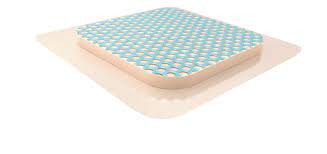-
Medical journals
- Career
Hydroresponsive Dressings for Acute and Hard-to-Heal Wounds
4. 8. 2022
A recently published review of clinical evidence from nearly three dozen studies demonstrates successful debridement and cleansing of various hard-to-heal wounds using HydroClean hydroresponsive dressing, with favorable healing outcomes.
Barriers to Wound Healing in Clinical Practice
In the treatment of hard-to-heal wounds, healthcare providers encounter numerous obstacles. These include the presence of devitalized tissue on the wound surface, which not only presents a physical barrier to healing but also serves as a source of bacterial contamination with a risk of subsequent infection. British authors recently published a review article summarizing the clinical study results with HydroClean hydroresponsive dressings published between 1970 and 2021 as a means of addressing this complication.
Properties of Hydroresponsive Dressing
HydroClean dressings are designed for wounds that need debridement/cleansing and exudate management, which are conditions necessary for supporting an optimal wound environment and successful healing. This dressing has several key properties, including debridement and removal of devitalized tissue, biofilm breakdown on the wound surface, microorganism absorption, matrix metalloproteinases and bacterial endotoxins absorption, and finally, sequestration, retention, and immobilization of microorganisms within the dressing material, followed by removal during routine dressing changes.

Favorable Healing Effects and Greater Patient Comfort
Studies retrieved from the PubMed database demonstrate that HydroClean supports successful debridement and cleansing of various wounds, including hard-to-heal wounds, facilitates bed preparation, and leads to favorable healing outcomes, even for wounds where previous healing attempts failed. For more severe wounds, support for granulation, and management of exudation and moisture were also shown. Results further indicate a reduction in wound infection incidents, pain relief, and less pain during dressing changes. The simple application of this standalone dressing also allows easy use for both acute and hard-to-heal wounds.
Conclusion
The documented effects of HydroClean dressings, including their antimicrobial action and ease of use, combined with greater patient comfort, make them an ideal choice for first-line therapy of acute and hard-to-heal wounds.
(zza)
Source: Ousey K., Hodgson H., Rippon M. G., Rogers A. A. Hydro-responsive wound dressings for treating hard-to-heal wounds: a narrative review of the clinical evidence. J Wound Care 2021 Dec 2; 30 (12): 980–992, doi: 10.12968/jowc.2021.30.12.980.
Did you like this article? Would you like to comment on it? Write to us. We are interested in your opinion. We will not publish it, but we will gladly answer you.
Labels
Dermatology & STDs Paediatric surgery Diabetology Vascular surgery Surgery Internal medicine General practitioner for adults
Login#ADS_BOTTOM_SCRIPTS#Forgotten passwordEnter the email address that you registered with. We will send you instructions on how to set a new password.
- Career

